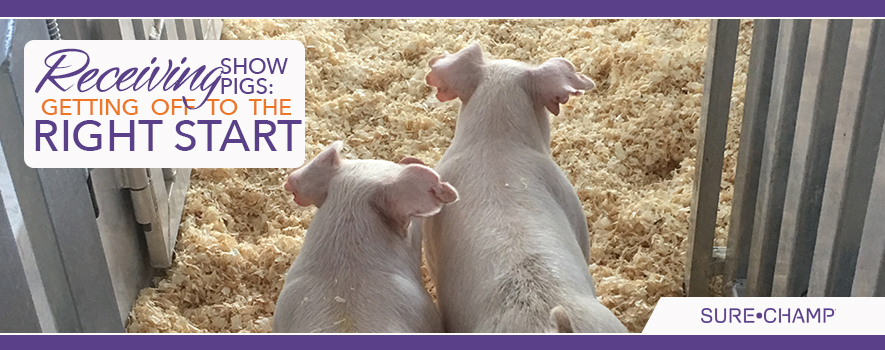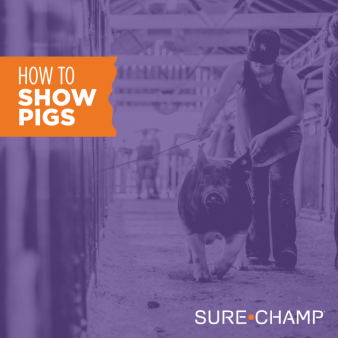
Getting your show pig off to a good start is one of the most important aspects for feeders to consider. The “receiving” phase is one of the most stressful times in a show pig’s life, so steps need to be taken to ensure the transition from the breeder’s farm to your barn is as easy as possible for your pig(s). Laying the proper foundation from a nutritional standpoint is a key step when receiving baby pigs.
FEEDING & NUTRITION:
Studies have shown it is advantageous to incorporate Amaferm® into a show pig’s diet at this stage. Amaferm®️ is a prebiotic designed to enhance digestibility by amplifying the nutrient supply for maximum performance. It is research-proven to increase intake, digestion and absorption.
There are two options for incorporating Amaferm into your pig’s diet; through Vita Charge® and Sure Champ®. Using Vita Charge at this stage is the quickest and most effective way to boost appetite by keeping their energy high and digestive system functioning correctly. Use Vita Charge Liquid Boost® or Gel to get an initial stimulant response for the first 3-5 days after bringing your pig home. Liquid Boost can be can administered through a water medicator or top-dressed on feed or in water as directed on the label. Vita Charge® Gel can be administered orally or on top of their feed. When possible, it is also helpful to give Vita Charge gel while loading pigs from the farm to help them battle the stress of the haul to your facility. These Vita Charge products are always great to have on hand throughout the year and at shows as a tool to help combat stress, hauling, illness, etc.
Sure Champ Spark® is recommended to begin feeding as soon as you get your pig home and throughout the remainder of the feeding period until show day as a daily maintenance product to keep Amaferm in their diet. Keeping Amaferm in their diet daily, using Sure Champ Spark, will help you to continue to maximize appetite and digestive health in your show pig, and increase their ability to maintain consistent and high consumption throughout the entire feeding period.
If during any time in the feeding period, temperatures remain consistently over 70 degrees, consider incorporating Sure Champ Extreme with Climate Control into the diet instead of Sure Champ Spark. This daily top-dress supplement is designed to help eliminate heat stress in the animals due to increased temperatures, high humidity or extreme shifts in temperatures or climate. In addition to the Amaferm, it contains plant extracts that support the animal’s ability to maintain normal body temperatures.
Next, the feed ration that you choose should be somewhat like the breeder’s to make the transition to your show barn less stressful. Ask the breeder what feed the pig was on from a protein, fat, lysine, and medication standpoint and keep your pig on a feed that is similar.
Several other important points in receiving are: facilities, environment and health.
FACILITIES & ENVIRONMENT:
Another significant step in successfully receiving baby pigs is to have the correct facilities. It is key to have your barn cleaned and disinfected before receiving your new set of pigs.
Have your shavings in place, feeder hung and a clean water source available before you bring your pig home (Video: How to Set Up A Pen Pig Pen). Make sure that both the feeder and water source is at the correct height so that the pig can easily reach them. As your pig grows throughout the season you will need to re-evaluate and change the height of their feeder and water source to make sure they are easily accessible. Be sure that your pig learns your water system. Some pigs may be used to a bowl waterer and some may already know a nipple waterer. Pay attention at the breeder’s farm to see what type of water system your pig is accustomed to, and if it is different than yours, watch closely to ensure your pig becomes familiar with your water system and is drinking enough.
When you purchase a pig from a breeder it may be coming from a nursery or a “chip barn” setting. The younger your pig, the more likely it came out of the breeder’s nursery facility. Why is this important? It is good to know the type of environment that a pig has been accustomed to so that you can try and keep its ambient temperature relatively close to what it is used to. Most nursery facilities are kept between 80-90 degrees. Pigs in a chip barn may be kept at a little wider temperature range. At any rate, pigs that are brought home at 6-10 weeks old do the best when temperature is kept at a comfortable level, as constant as possible. Be sure that your pens block any wind draft that may be occur.
If you have a white or blue pig be sure that no sunlight can reach their pen. Having your facilities set up correctly and at a comfortable temperature is imperative to decreasing the stress on your project.
HEALTH:
Deworm your pigs a week to ten days after bringing them home, (or if you male pigs that need to be castrated, waiting until castration time is also fine). This gives them time to adjust to their new environment and is important in managing their health. Talk to your breeder and ask if they have already been dewormed, if so, when and with what product so that you are up to speed on their current health needs. It is also a good idea to ask your breeder about any vaccinations that your pig has been given or about any boosters that they may need.
By being proactive from a nutrition standpoint, keeping feed rations consistent, and placing them in a clean and comfortable environment while closely monitoring their health, you will be making a successful and easy transition for your pig from the breeder’s farm to your barn. We wish everyone the best of luck in this upcoming show season!

